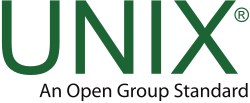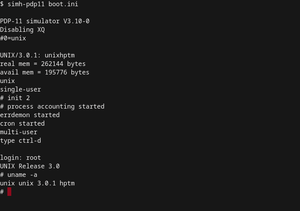
Back Unix Afrikaans UNIX ALS Unix AN يونكس Arabic Unix AST Unix Azerbaijani Unix BAR UNIX BAT-SMG Unix Byelorussian UNIX BE-X-OLD
 | |
 Unix System III running on a PDP-11 simulator | |
| Developer | Ken Thompson, Dennis Ritchie, Brian Kernighan, Douglas McIlroy, and Joe Ossanna at Bell Labs |
|---|---|
| Written in | C and assembly language |
| OS family | Unix |
| Source model | Historically proprietary software, while some Unix projects (including BSD family and illumos) are open-source |
| Initial release | Development started in 1969 First manual published internally in November 1971[1] Announced outside Bell Labs in October 1973[2] |
| Available in | English |
| Kernel type | Varies; monolithic, microkernel, hybrid |
| Influenced by | CTSS,[3] Multics |
| Default user interface | Command-line interface and Graphical (Wayland and X Window System; Android SurfaceFlinger; macOS Quartz) |
| License | Varies; some versions are proprietary, others are free/open-source software |
| Official website | www |
Unix (/ˈjuːnɪks/, YOO-niks; trademarked as UNIX) is a family of multitasking, multi-user computer operating systems that derive from the original AT&T Unix, whose development started in 1969[1] at the Bell Labs research center by Ken Thompson, Dennis Ritchie, and others.[4]
Initially intended for use inside the Bell System, AT&T licensed Unix to outside parties in the late 1970s, leading to a variety of both academic and commercial Unix variants from vendors including University of California, Berkeley (BSD), Microsoft (Xenix), Sun Microsystems (SunOS/Solaris), HP/HPE (HP-UX), and IBM (AIX). In the early 1990s, AT&T sold its rights in Unix to Novell, which then sold the UNIX trademark to The Open Group, an industry consortium founded in 1996. The Open Group allows the use of the mark for certified operating systems that comply with the Single UNIX Specification (SUS).
Early versions of Unix ran on PDP-11 computers.
Unix systems are characterized by a modular design that is sometimes called the "Unix philosophy". According to this philosophy, the operating system should provide a set of simple tools, each of which performs a limited, well-defined function.[5] A unified and inode-based filesystem and an inter-process communication mechanism known as "pipes" serve as the main means of communication,[4] and a shell scripting and command language (the Unix shell) is used to combine the tools to perform complex workflows.
Unix distinguishes itself from its predecessors as the first portable operating system: almost the entire operating system is written in the C programming language, which allows Unix to operate on numerous platforms.[6]
- ^ a b McIlroy, M. D. (1987). A Research Unix reader: annotated excerpts from the Programmer's Manual, 1971–1986 (PDF) (Technical report). CSTR. Bell Labs. 139. Archived (PDF) from the original on 11 November 2017.
- ^ Ritchie, D. M.; Thompson, K. (1974). "The UNIX Time-Sharing System" (PDF). Communications of the ACM. 17 (7): 365–375. CiteSeerX 10.1.1.118.1214. doi:10.1145/361011.361061. S2CID 53235982. Archived (PDF) from the original on 11 June 2015.
- ^ Ritchie, Dennis M. (1977). The Unix Time-sharing System: A retrospective (PDF). Tenth Hawaii International Conference on the System Sciences.
a good case can be made that [UNIX] is in essence a modern implementation of MIT's CTSS system
- ^ a b Ritchie, D.M.; Thompson, K. (July 1978). "The UNIX Time-Sharing System". Bell System Tech. J. 57 (6): 1905–1929. CiteSeerX 10.1.1.112.595. doi:10.1002/j.1538-7305.1978.tb02136.x. Retrieved December 9, 2012.
- ^ Raymond, Eric (19 September 2003). The Art of Unix Programming. Addison-Wesley. ISBN 978-0-13-142901-7. Archived from the original on 12 February 2009. Retrieved 9 February 2009.
- ^ Ritchie, Dennis M. (January 1993). "The Development of the C Language" (PDF). Archived (PDF) from the original on 11 June 2015. Retrieved 30 July 2022.
© MMXXIII Rich X Search. We shall prevail. All rights reserved. Rich X Search